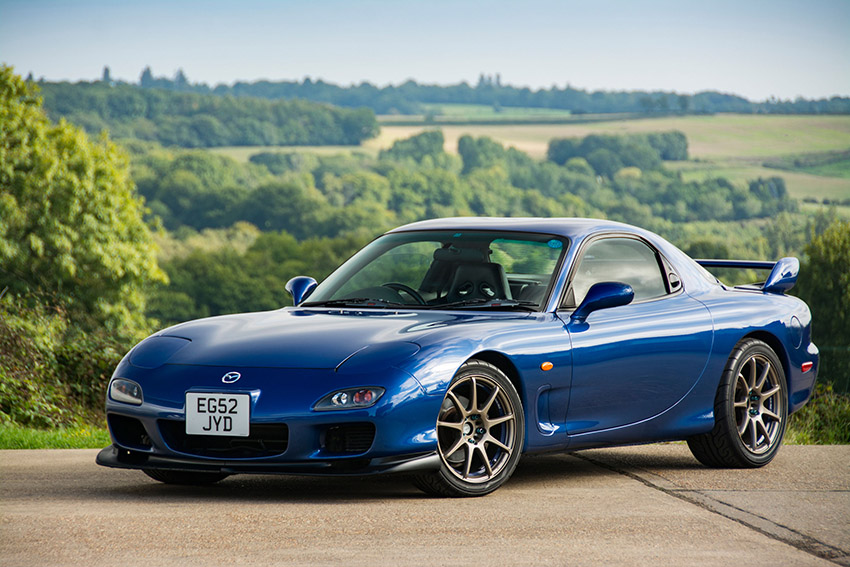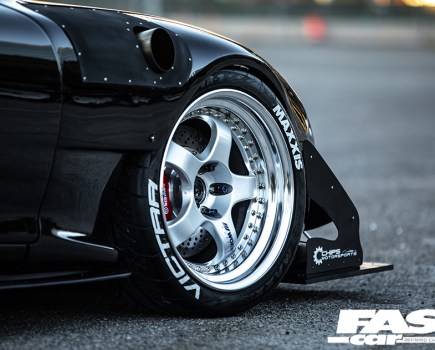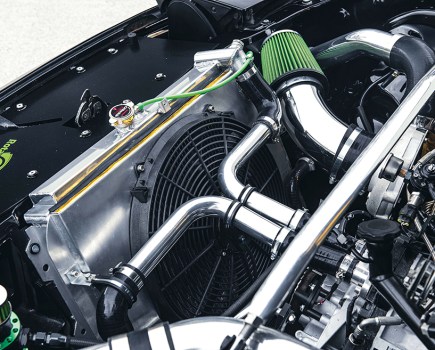The third-gen Mazda RX-7 FD represents the peak of rotary-powered sports cars. Here’s everything you need to know about the famous Japanese Classic.
Mazda RX-7 FD History
By the time the nineties had rolled around, Mazda’s successful RX-7 needed a bit of freshening up. Whereas the previous ‘FC’ was slightly more touring focused, the new FD looked radically different, and made to feel radically different too. Be sure to check out our ultimate guide to the Mazda RX-7 for information on the older generation cars.
The FD RX-7’s soft curves stood out amongst the rest of its angular, blocky JDM rivals. The car’s svelte appearance was matched by its underpinnings, which had been tweaked to offer a more sporting drive. Nicely weighted steering gave drivers the sort of feedback they needed to tackle corners with precision. Meanwhile, the engine had evolved into something suitably potent. This was achieved thanks to a complex twin turbo system, whereby the second snail only kicks in after 4000rpm.
The result was 236hp in the Euro-spec cars, though Japanese and American market FDs (many have since been imported) left the factory with north of 250. As the 13B-REW engine has 1.3-litre capacity, it was simple to tuck away behind the front axle for a 50:50 weight distribution. The motor’s packaging also gives the FD a low center of gravity, making it a genuinely compelling vehicle to drive.
However, not all FDs were born equal. After all, this car was in production for the best part of a decade. Cars produced between 1992-1995 are referred to as Series 6. Over in Japan, they could be had in six different variations; from performance-focused models like the Type RZ, to the Touring X which came with a four-speed auto box. Over here in Britain, things were kept nice and simple; just one option, which had the suspension from Mazda’s sportier home-market RX-7s.
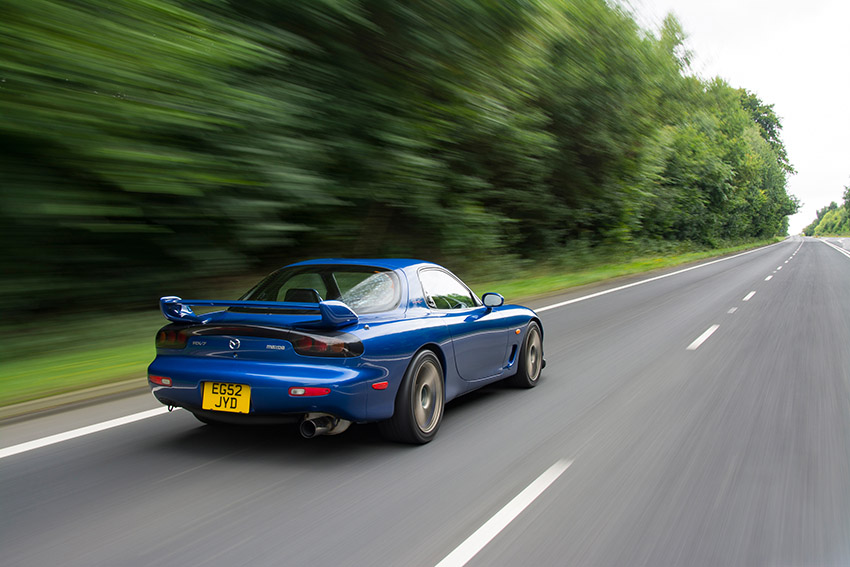
Series 7 and 8 Updates
Series 7 arrived in 1996, but this was only really a minor facelift. The rear wing was redesigned, as were some elements of the interior. A revised ECU gave the car fractionally more power. Series 8 of 1998 was a more headline-grabbing evolution of the FD though. In this iteration, Type RB cars had their power upped to 260hp, while the top line examples boasted 276hp. This included the Type RS. This came equipped with upgraded Bilstein suspension, a longer fifth gear, and reduced curb weight. The Type RZ, meanwhile, took things a step further. On top of the RS features, the RZ had a dynamic ABS system and came with 17-inch BBS alloys. Another 10kg was shaved off of it too.
The most sought-after FD RX-7 of them all, however, is the Spirit R. Changes made to these were actually relatively minor; upgraded brakes where perhaps the biggest draw, though an exclusive Titanium Grey was also on offer. Only 1500 of these flagships were ever made, which probably explains the hype around the Spirit R. Well, that, and its Gran Turismo fame.
In summary, the Mazda RX-7 FD was – and still is – a terrific driver’s car. You don’t need to have the ultimate trim level to experience it at its best. That said, whichever spec you go for, the RX-7 is a big investment. It requires a lot of TLC to keep healthy. So, before you make your rotary dreams a reality, have a quick read of this.
Mazda RX-7 FD most common problems
- Blown apex seals
- Improper oil maintenance
- Heat-damaged engine bay components
- Rough fifth gear
- Knackered suspension
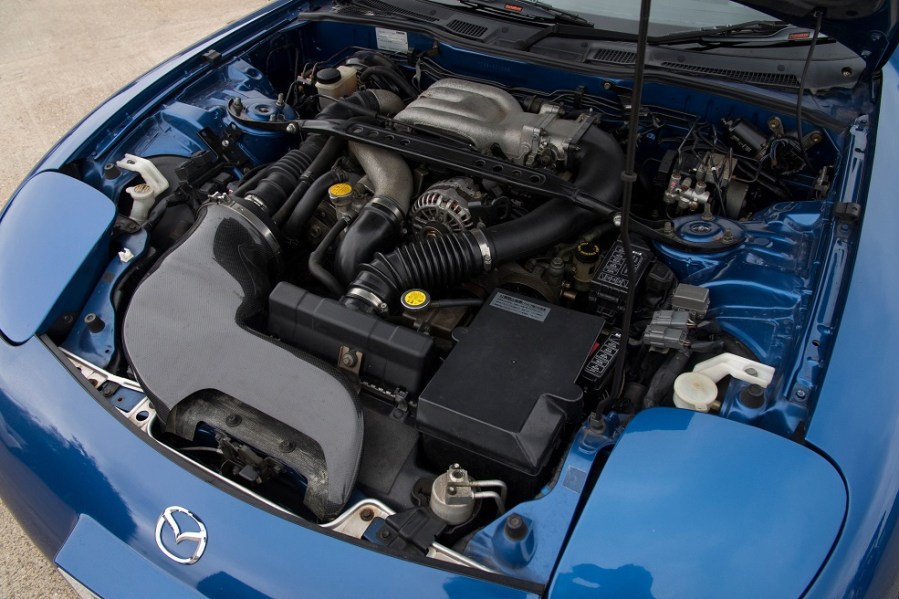
What to look out for on the Mazda RX-7 FD
Below, we’ve broken down each key component of the car to help you better understand the RX-7 FD. We’ll look at potential issues to be aware of, as well as general information and servicing. And if you’re wondering why these cars are loved so much, check out my RX-7 Bathurst Type R review.
Engine
It’s a common cliché to question the reliability of rotary engines. The reality, however, is often far less scary than the online discourse would have you believe. Truth be told, if the 13B-REW is maintained well, it can easily live beyond 100,000 miles. If it isn’t looked after, though, you could be looking at a full rebuild at less than half that mileage. As such, it’s crucial that you buy from a seller who’s in the know about what it takes to run one..
By far the biggest thing you’ll want to check for in this regard is a solid service history. Rotary engines burn oil by design. That means they need their fluid levels topped up much more often than a regular piston engine. Ideally, you’d want to see evidence in writing that the car’s been given oil change every 3000-5000 miles. Also check for a new oil filter fitted on most of those occasions. It’s also worth noting that many owners will choose to fully flush the oil and replace it after a track day. Ask the seller if they’ve taken the car on track to see whether its servicing history matches up.
If it seems as though they’ve done well at keeping on top of the car’s servicing schedule, the next question to ask would be: “So, what type of oil do you use?”. Many engine oils these days are synthetic, however synthetics don’t burn, and that makes them incompatible with rotary engines. What you’ll end up with is a car that’s clogged up with deposits and debris. This will eventually lead to broken apex seals (more on that later!) and terminal engine damage. Instead, you’ll want to buy a car which has been exclusively serviced with mineral-based engine oil that’s high in zinc.
Rotary checks
Assuming nothing has put you off about the car so far, the next crucial thing to do would be to perform a compression test. You’ll want to be looking at readings which are close to – or slightly above – 100 psi (7.0 bar) with no more than 20 psi difference between each chamber. Measurements lower than 80 psi (6.0 bar) are indicative of an engine that’s on the way out. Often, the cause of low compression figures will be a worn apex seal, or side seal.
Aside from that, you’ll also want to cast your eyes over the vacuum lines connected to the twin turbo set-up. The engine bay gets notoriously hot in the Mazda RX-7 FD, original lines can perish in the conditions after time. If they feel stiff rather than rubbery, then they’ll need to be replaced.
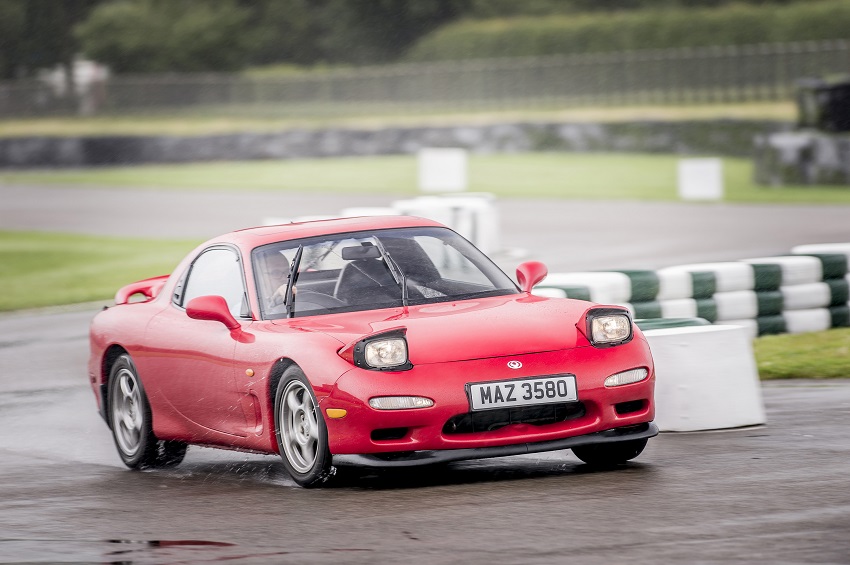
Now here’s the fun bit – the test drive. Naturally, there’s a few things that you’ll want to be watching out for, the first of which is the idle. A healthy warm engine should idle around the 800rpm-mark, so any major variation upon that would suggest that something’s awry. Then, check what’s coming out the tailpipes. Steam upon start-up might suggest that the hot engine bay has caused the RX-7’s coolant seals to waste away. In fact, speaking of coolant, it’s important that the seller has replaced it every year. Old fluid can deteriorate the seals too. Coolant leaks aren’t unheard of, so have a look to see whether there’s any evidence dripping away underneath the car.
Transmission
With those checks all sorted, it’s time to hit the road. The clutch is pretty capable of handling the FD’s stock internals. It’s unlikely to cause you much concern if you’re looking at a largely standard car. However, one thing that can be a problem is the second turbo within the twin system. Sometimes these can fail, either due to heat, or lack of use from overly cautious drivers. To test whether everything’s in order, you’ll need to take the car into the higher end of its rev range. If it’s all as it should be, you’ll feel a small extra splurge of power when the second turbo spools at around 4500rpm.
As for the gearbox? Well, these are pretty robust so long as you’re dealing with relatively stock power levels. That said, the shift from fourth into fifth is known to be an area that suffers from synchromesh wear.
The final thing to say about the Mazda RX-7 FD’s powertrain is that most examples will be modified in some way. If done well, this can turn the FD into an entirely different beast, but ask yourself whether you trust the workmanship. If it whiffs of a bodge job, then there’s no shame in walking away.
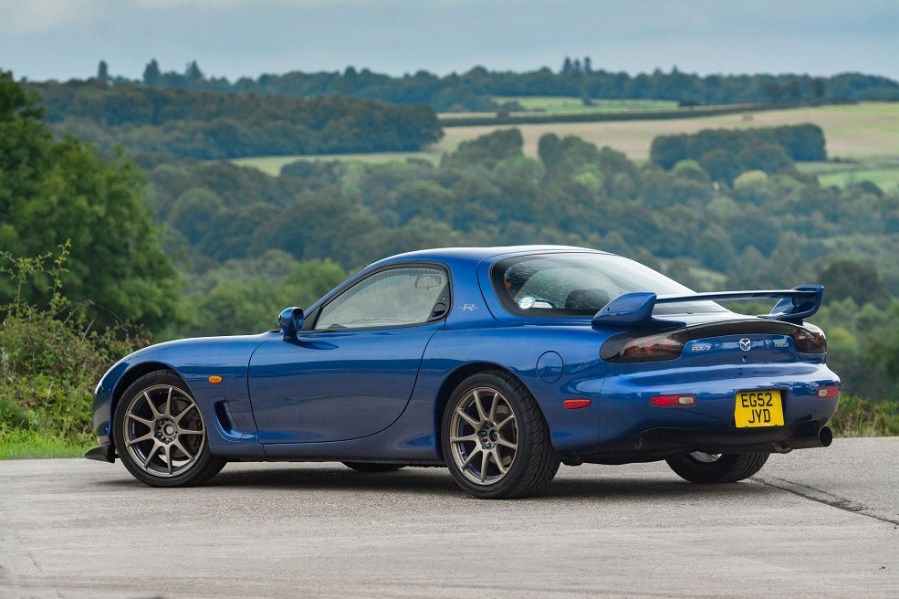
Suspension
The good news is that if you’ve made it this far, the car you’re viewing doesn’t have too many more tests to pass. Generally speaking, the rest of the RX-7 FD beyond the powertrain tends to survive rather well. However, with a car this age, there’s always elements of its underpinnings that you need to be checking.
Let’s start with the suspension. By this point, it’s quite likely that the bushings and other perishable parts will be in need of attention, so have a look through the car’s history to see if this has ever been done. Has it been lowered? If so, make sure that the plastic wheel liners haven’t been removed. If they have, then you’re just asking for moisture to start wreaking havoc with the car’s wiring.
The seller’s choice of alloys can have an impact too. Unless you’re looking at a high-spec Japanese import, the FD is at its happiest when on a set of 16-inch rims. Anything more than that will not only create a harsher ride, but also begin to strain the stock suspension too. So, if there are 17s or 18s fitted to the car, you’d ideally want it to have upgraded suspension to cope. Keep an ear out for any knocking from the rear too.
Brakes
The standard brakes are generally deemed sufficient to cope with the stock iteration of the Mazda RX-7 FD but check to make sure that they aren’t worn. The hydraulic assisted steering, meanwhile, should still be in fine health despite its age.
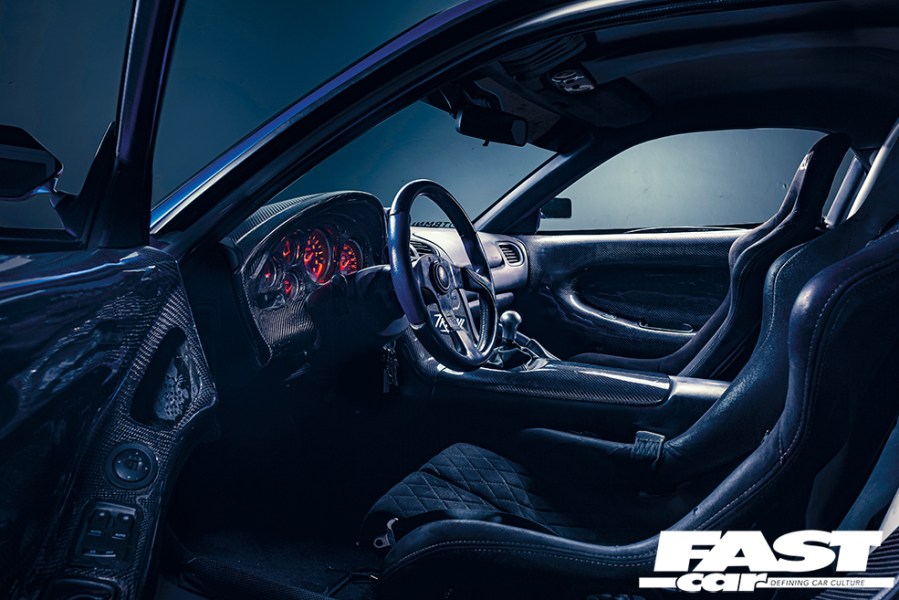
Interior
The inside of the car is the best place to find out for sure whether you’re looking at a genuine UK market RX-7, or a JDM import. British cars have storage compartments in the back, whereas a Japanese car will have a bench of seats (unless of course, it’s a stripped-out track racer).
The actual materials used within the FD’s interior are fairly tough, but by now you should expect to see at least some signs of wear and tear on the key touchpoints within the cabin: steering wheel, gearstick, driver’s seat being the main ones. Occasionally the hinges for the door pockets can snap too, and they’re not an easy thing to replace.
Air conditioning came as standard on the Mazda RX-7 FD, so make sure it’s working if you plan on using the car in summer at all. Plus, depending on its age, you might notice a different look to the driver’s gauges. Series 6 cars have red lighting, whereas the Series 7 cars came with green. Something different entirely points to the gauges being of an aftermarket spec, which tends to mean that the car’s been tuned. So, if the owner’s been quiet about things on that front up to now, it’s probably worth quizzing them about it.
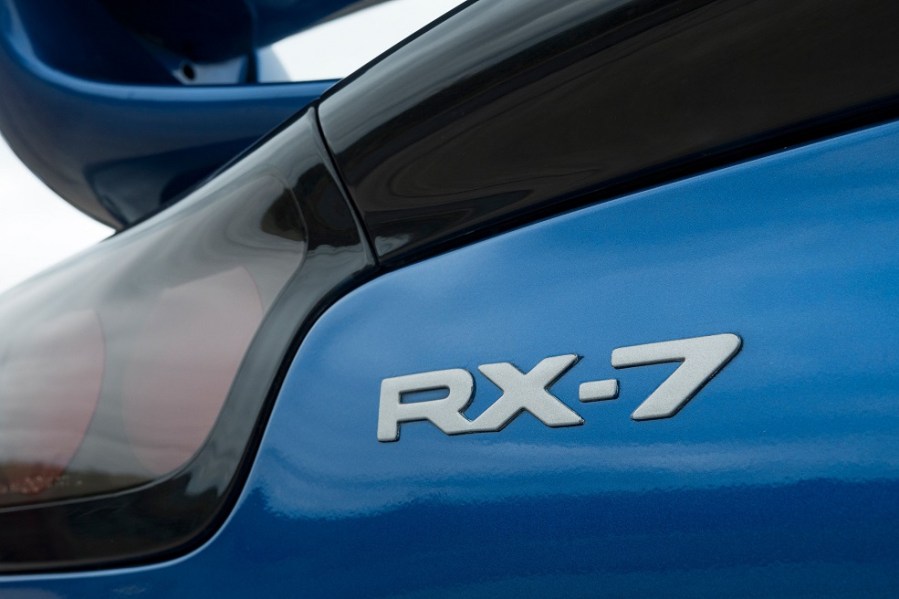
Exterior
Modifications are likely to be the first thing you notice about any Mazda RX-7 FD’s exterior – it feels as though most these days have been restyled, whether it be in the form of a revised aero package, or a full-on widebody kit. As is the case with any mod, just be sure that the work’s been done to a good standard.
All the rules about rust and old cars still absolutely apply here too. Check the wheel arches and sills as you would on any vehicle, and the chassis too. FD-specific weak points include the area underneath the brake lights, and also the rear wing. Decades of opening the boot by pulling the wing up can allow moisture to collect within its joins, or if the spoiler’s been deleted, make sure that the remaining holes have been filled to a professional standard.
Other than that, door handles – both outside and in – can be fragile, and it’s also worth keeping in mind that replacement body panels are quite scarce.

Mazda RX-7 FD Prices
Unfortunately, prices for collector cars are through the roof at the moment, and there’s no exception to the trend here. Series 6 cars that have exceeded 100,000 miles will still command somewhere around $25,000 / £20,000, while clean early models with less miles under the hood can fetch up to 35 grand. If, however, they’ve had desirable upgrades fitted, such as an RE Amemiya bodykit, you might be looking at a value closer to $/£40,000.
Looking at the worldwide RX-7 market as a whole though, prices can reach much greater heights than that, especially for well-kept Series 7 & 8 cars. Standard examples of these with 70,000 miles or less on the odometer will typically cost between $35,000-$65,000 / £40,000-£60,000 at this point, however the values attributed to the cream of the crop are downright bonkers. Immaculate high-end Series 8s can demand more than $/£70,000, while untouched Spirit Rs have climbed perilously close to the six-figure threshold. Sadly, buying a healthy FD isn’t going to be cheap anymore, whatever end of the market you’re in.
On average, in the US prices range from around $25,000 up to $60,000 depending on condition and modification status. In the UK, the Mazda RX-7 FD is probably a £30,000-£50,000 car these days. Mind you, when you see the sort of money that other Japanese icons are going for, that figure doesn’t seem quite so bad.
Tech Spec: Mazda RX-7 FD (Series 6)
- Engine: 1308cc wankel rotary
- Max Power: 236hp at 6500rpm
- Max Torque: 218lb ft at 5000rpm
- Transmission: five-speed manual
- Max speed: 155 mph
- 0-62mph: 5.4 seconds
- Weight: 1284kg
- Economy: 25.5 mpg
Love performance cars? Don’t forget that we host a number of car events throughout the year. Head over to our Fast Car Events page for more info on what’s coming up next.

